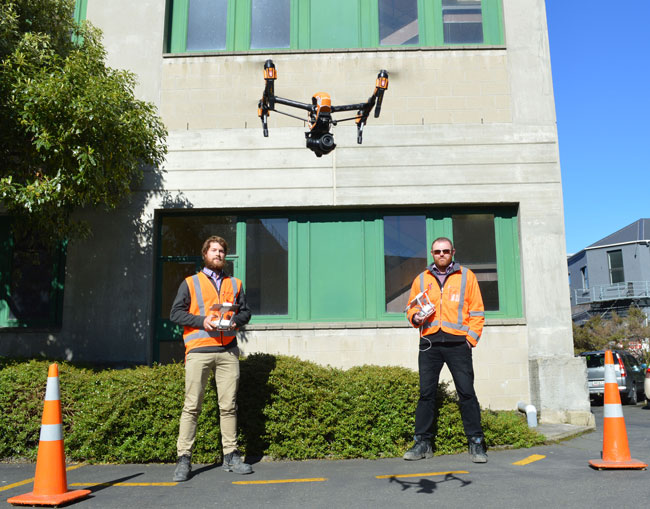Thursday 18 October 2018 10:24pm

Scott Kvick and Dave Ellis use a drone to examine the exterior of the Adams building.
Using a drone to survey a University building transformed the task – making it safer, less disruptive, less time-consuming and much more cost effective.
The emerging use of drones means examining the condition of the exterior of the eight-storey Adams building did not have to involve hiring two cranes for two days, blocking access to carparks around the building.
Nor did the structural engineer have to get into a cage hanging from the crane boom then be raised to examine every part of the building’s exterior, University of Otago Campus Development Division Director David Perry says.
"I’ve done surveys of very large buildings from a crane but, seeing this now, I could easily use a drone to do it cheaper and get to more places."
That work would probably have been done over a weekend but instead WSP Opus was on-site for about six hours during a work day and only blocked off a small area for the drone’s landing pad, while the structural engineer kept his feet on the ground.
Standing side-by-side, intermediate engineer and unmanned aerial vehicle pilot Scott Kvick followed instructions from senior structural engineer Dave Ellis as he controlled the drone’s camera while watching a screen showing images from the camera.
Mr Ellis also knew he could get an even closer look by zooming in much further on the photos on a screen back in the office.
Principal Structural Engineer Andrew Blacker originally thought drones were “a bit of gadgetry" and "we’ll see how it goes”.
“One of the things engineers like to do is put their hands on things to get an idea about how they work. I’ve done surveys of very large buildings from a crane but, seeing this now, I could easily use a drone to do it cheaper and get to more places.”
Mr Kvick says he expects to get more work piloting the $15,000 drone as using the technology to survey buildings becomes more accepted.
Most of the drone’s cost is in its batteries and they are needed – surveying the six sides of the Adams Building used at least one battery for each side so he had to use a total of six batteries because they take some time to charge.
WSP Opus has another drone with a top-mounted camera that can survey the underside of bridges and viaducts, and about eight Phantom drones for aerial mapping work.
